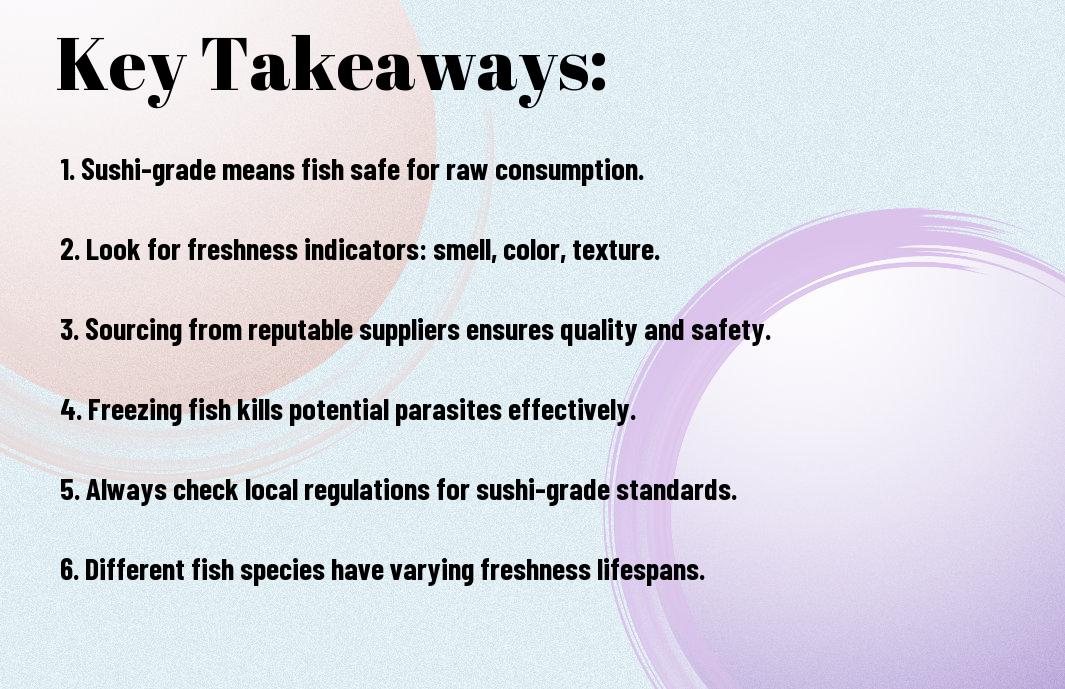Understanding sushi-grade fish is crucial for anyone looking to enjoy high-quality sushi at home or in a restaurant. This guide will help you navigate the various types of fish available, what to look for when purchasing, and the importance of sourcing from reputable suppliers. By following these insights, you’ll ensure that your sushi experience not only tastes incredible but is also safe for consumption. Dive into the world of sushi-grade fish and elevate your culinary adventures.
Key Takeaways:
- Sourcing: Always buy fish from reputable suppliers who specifically label their products as sushi-grade to ensure safety and quality.
- Freezing Standards: Sushi-grade fish should be frozen at specific temperatures to kill parasites, which is vital for safe raw consumption.
- Freshness: Look for fish that exhibits firm texture, bright color, and a clean, ocean-like smell, as these are indicators of freshness.
- Species Type: Familiarize yourself with common sushi-grade fish varieties, such as tuna, salmon, and mackerel, for optimal sushi-making.
- Handling Techniques: Follow proper handling and preparation techniques when working with sushi-grade fish to ensure the highest quality and safety.
Understanding Sushi-Grade Fish
As you initiate on your sushi-making journey, understanding sushi-grade fish is important. This term refers to seafood that is safe for raw consumption, indicating a level of quality and freshness that meets stringent health standards. With various species of fish in the market, knowing how to identify sushi-grade options can elevate your culinary experience and ensure your safety while enjoying this delicacy.
Definition of Sushi-Grade Fish
Before you select your fish, it’s important to clarify what sushi-grade actually means. Typically, this designation indicates that the fish has been frozen at specific temperatures to eliminate harmful parasites, making it safe to consume raw.
Standards and Regulations
For you to truly appreciate sushi-grade fish, understanding the standards and regulations that govern its classification is beneficial. These guidelines ensure that the fish you choose has been processed and handled in a way that minimizes health risks.
SushiGrade emphasizes that various organizations, such as the FDA and local health departments, provide standards for sushi-grade fish. These regulations stipulate freezing protocols that kill parasites and ensure the fish’s freshness. As a consumer, it’s important you source your fish from reputable suppliers who adhere to these standards to guarantee you are purchasing high-quality sushi-grade fish, making your dining experience both enjoyable and safe.
Types of Sushi-Grade Fish
There’s a variety of sushi-grade fish that you should be familiar with when hunting for quality ingredients. Here’s a list of some common types:
- Tuna
- Salmon
- Yellowtail
- Mackerel
- Snapper
Knowing the differences among these fish will help you select the right options for your sushi creations.
| Fish Type | Flavor Profile |
|---|---|
| Tuna | Rich, meaty |
| Salmon | Buttery, rich |
| Yellowtail | Light, slightly sweet |
| Mackerel | Bold, strong |
| Snapper | Delicate, mild |
Common Varieties
Varieties of sushi-grade fish include favorites like tuna, salmon, and yellowtail. Each type boasts unique textures and flavors, allowing you to create diverse sushi experiences. Selecting the right variety will enhance your sushi dishes while catering to your taste preferences.
Seasonal Availability
Any sushi-grade fish may have specific times of the year when they are at their best. This seasonal availability can influence freshness and flavor, making some fish more desirable than others during different times of the year.
For instance, certain varieties like tuna are often more abundant in the warmer months, while salmon tends to peak in early spring or late fall. Familiarizing yourself with when specific fish are in season helps ensure that you are choosing the freshest, highest quality ingredients for your sushi preparations.
Sourcing Sushi-Grade Fish
Once again, sourcing sushi-grade fish is imperative for those who want to enjoy the delicate flavors and textures of raw seafood safely. To ensure freshness and quality, it’s important to find reputable suppliers who adhere to strict handling practices. Look for fish labeled as “sushi-grade” or “sashimi-grade,” as these designations indicate the fish meets specific standards for raw consumption.
Where to Buy
One excellent option for purchasing sushi-grade fish is your local fish market or seafood specialty store. These places often provide more information about their sourcing practices and can help you choose the right fish for sushi. Additionally, some supermarkets have dedicated seafood counters where you can find high-quality options, but always ask about their freshness and handling procedures.
Identifying Quality Fish
Fish is considered sushi-grade when it has been frozen at specific temperatures to eliminate parasites and bacteria. Look for fish with bright, clear eyes, vibrant colors, and firm flesh that springs back when pressed. Fresh sushi-grade fish should also have a clean, ocean-like aroma without any off-putting smells.
Consequently, it’s important to inspect every aspect of the fish before making a purchase. The texture should be smooth and shiny, indicating freshness, while marbled fish like salmon should have well-defined, translucent fat lines. If you’re unsure, don’t hesitate to ask your fishmonger for advice on the best options available, ensuring a safe and delicious sushi experience.

Safety and Handling
Many people underestimate the importance of proper safety and handling when it comes to sushi-grade fish. Ensuring you have the right practices in place is crucial to minimize the risk of foodborne illnesses. Sushi-grade fish must be handled with care, so it’s important to understand how to maintain its quality from the moment you purchase it until you’re ready to enjoy your meal.
Storage Tips
Among the key aspects of safely handling sushi-grade fish is knowing how to store it properly. Whether you’re purchasing fish from a market or having it delivered, it’s vital to follow these guidelines:
- Keep your fish refrigerated at 32°F (0°C).
- Store it in the coldest part of your refrigerator.
- Use airtight containers to prevent cross-contamination.
- Consume the fish within 24 hours for the best quality.
The goal is to maintain freshness and prevent spoilage.
Preparation Guidelines
Beside proper storage, preparation plays a significant role in ensuring safe sushi-making. You should always use clean utensils and cutting boards designated for fish to avoid contamination. Thoroughly wash your hands before and after handling any seafood and be mindful of your surroundings to prevent cross-contact with raw ingredients.
It is also advisable to inspect the fish for any off smells or unusual textures before preparation. When cutting fish, sharp and sanitized knives will yield the best results and help maintain the integrity of the fish. Always slice against the grain to preserve tenderness. By following these guidelines, you can ensure that your sushi preparation process remains as safe and enjoyable as possible.
Health Benefits of Sushi-Grade Fish
To enjoy sushi-grade fish is not only a culinary delight but also brings numerous health benefits. Packed with imperative nutrients, this type of fish can enhance your diet and contribute to your overall well-being. For more insights on what qualifies as sushi-grade fish, check out What Is Sushi Grade Fish?.
Nutritional Value
With sushi-grade fish, you receive an excellent source of high-quality protein, vitamins, and minerals. This nutrient-dense food contributes to strong muscles and healthy bodily functions, making it a smart addition to your meals.
Omega-3 Fatty Acids
Benefits of sushi-grade fish include its high content of omega-3 fatty acids, which are imperative for your heart and brain health. These fatty acids have been linked to reduced inflammation and improved cognitive function, making them a valuable component of a balanced diet.
Consequently, incorporating omega-3 fatty acids from sushi-grade fish can support your cardiovascular health by lowering blood pressure and reducing the risk of heart disease. Additionally, they play a significant role in maintaining optimal brain function, which can enhance your mood and memory. Embracing sushi-grade options can thus lead to lasting health benefits.
Sushi Preparation Techniques
For anyone interested in mastering the art of sushi-making, understanding the proper preparation techniques is imperative. Sushi-grade fish requires careful handling and specific methods to ensure safety and quality. You can find valuable insights in this guide about How to Choose Sushi-Grade Seafood.
Knife Skills
Any sushi chef will tell you that honing your knife skills is vital for preparing sushi. Proper technique ensures clean cuts that enhance the texture and presentation of your fish, allowing the flavors to shine. Practice different slicing methods, such as the “push and pull” technique, to achieve the perfect cut for sashimi or nigiri.
Plating and Presentation
Against common belief, plating is not just about aesthetics; it’s also about enhancing the dining experience. The way you present your sushi can elevate its appeal and make your dish more inviting. Consider using contrasting colors, unique arrangements, and decorative garnishes to showcase the freshness and artistry of your sushi.
At the end of the day, plating and presentation allow you to express your creativity while highlighting the quality of your ingredients. Strategic arrangements can guide your diners’ focus and enhance their anticipation. Experiment with different styles, like minimalist or elaborate designs, to find the best presentation that reflects your own culinary identity.

To wrap up
Summing up, understanding sushi-grade fish is important for ensuring safety and quality in your culinary creations. You should prioritize sourcing fish from reputable suppliers who adhere to strict food safety standards. Additionally, look for indicators of freshness, such as clear eyes and firm texture. By making informed choices and handling your fish properly, you can enjoy a delightful sushi experience at home. Your commitment to these practices not only enhances the flavors but also ensures a safer dining experience.
Q: What defines sushi-grade fish?
A: Sushi-grade fish refers to seafood that is deemed safe for raw consumption. It is typically frozen at very low temperatures to eliminate parasites and pathogens. The term is not regulated, so it’s important to buy sushi-grade fish from reputable sources that adhere to high safety standards. Look for clear labeling and ask fishmongers about their sourcing and handling practices to ensure the quality.
Q: How can I tell if the fish is fresh enough for sushi?
A: Fresh fish for sushi should have a clean, ocean-like smell, not a strong or fishy odor. The flesh should be firm and resilient to the touch, with a moist appearance. Additionally, the color should be vibrant and uniform without discoloration or dull spots. Inspect the eyes; they should be clear and bulging. It’s also wise to inquire when the fish was delivered to the seller for the most accurate indication of its freshness.
Q: What types of fish are commonly considered sushi-grade?
A: Various types of fish can be served as sushi, commonly including tuna, salmon, mackerel, and yellowtail. Tuna, especially bluefin, is often prized for its rich flavor and texture, while salmon is renowned for its buttery taste. Other favorites include halibut and sea bass. Typically, any fish that is safe for raw consumption can qualify as sushi-grade, but the best choices often depend on availability and personal preference.


